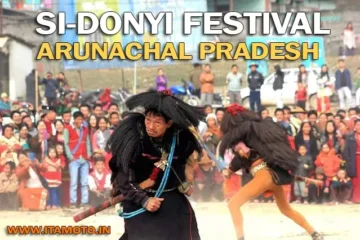Arunachal Pradesh is very rich in historical places as well as archaeological sites and monuments. There are three central, seven state protected, and 37 unprotected monuments in the State.
If you are planning to travel to Arunachal Pradesh, northeast, India then you must be searching famous historical places in Arunachal Pradesh or you might also are searching for “What are popular monuments and sites in Arunachal Pradesh?” on google search to make your trip to Arunachal Pradesh special and the best moment of your life, right?
Well, that’s a good idea to find out the answers to these questions before traveling to Arunachal Pradesh because you shouldn’t miss ” Best heritage sites or Monument of Arunachal Pradesh” while traveling in Arunachal Pradesh.
In this article, you’ll know all the famous historical places in Arunachal Prades and the best monuments and heritage sites of Arunachal Pradesh.
We are writing this as a travel guide to help you make your trip worth remembering and the best trip of your life. After reading this article till the end, you’ll able to choose which famous places or sites to visit in Arunachal Pradesh during your trip.
List of famous historical places in Arunachal Pradesh
Here I listed down some of the best heritage sites of Arunachal Pradesh are described below:
Malinithan: Likabali
Malinithan is one of the popular historical and archaeological sites situated in the foothills of the Lower Siang district. The Orissan-style architecture of the temple attracts thousands of visitors from other states and countries. Important sculptures are Indra on Airavata, Kartikeya on Peacock, Surya on Chariot, Nandi Bull, and Bramatical images, etc. Most of these are made of granite and sandstone. It is dated back to C. 10-12 AD. An interesting legend is associated with Malinithan. Malini-Mela associated with Malinthan historical site is organized every year in April related to the Basanti Puja. The first excavation was conducted in 1968.
Itafort: Itanagar
Itafort is situated in Itanagar, the capital city of Arunachal Pradesh, Papum Pare district. It is a historical fort of an irregular shape built mainly with bricks of various sizes. Total brickwork is16200 cubic meters in length.
This historical site has three gates on three sides i.e Eastern Gate, the Western Gate, and the Southern Gate. The fort bears testimony of its glorious built heritage.
It can be dated back to C. 1350 to 1550 A.D. built by the Chutiya dynasty It is estimated that more than 80 lakhs of bricks, 45 c. meters of stones, and 46300 man-days were required in building up the fort.
There is the Archaeological Museum situated at Western Gate. Hita-Rokpo was the local name for Itafort. The first excavation was conducted in 1974.
In recent renovation and maintenance works carried out in October 2016, a new base wall and bricks of two different sizes were unearthed. The bricks’ sizes are 22.0 x 8.5 x 5.5 cm and other 15.2 x 13.5 x 6.5 Cm.
Bhalukpung: West Kameng
It is situated on a hillock in the foothill of the West Kameng district. It was said to be the ancient capital of King Bhaluk, the grandson of Bana. No archaeological remains of the historical Fort now exist. It is dated back to C. 10th to 12th A.D. A Centrally protected monument.
Pakhui Game Sanctuary & Tipi Orchidarium are also the main tourist attractions in Bhalukpung which host over 2600 cultivated orchids from 80 different species
Naksaparbat : Pakke Kessang
It is situated in the Pakke Kessang district, Arunachal Pradesh. Significant archaeological findings are stonė built plinths of houses, a ring well, a few sculptural pieces, potteries, a pond, etc. belonging to the medieval Period (C. 14th-16th A.D.).
Hundreds of tourists from other states and countries visit the site every year to enjoy the archaeological and natural beauty.
Naksaparbat is an important Archaeological State Protected Site of Arunachal Pradesh. It is the largest Archaeological excavated site of Arunachal Pradesh having a vast and complete habitational site belonging to the 14th -15th century A.D.
Naksaparbat is surrounded by two hilly beautiful small streams namely Namurah and Borgang.
Vijayanagar Stupa: Changlang
Vijaynagar also called Vijoynagar is a small town in the remote Tehsil circle of Chalang district, Arunachal Pradesh and its local name is “Daudi” called by the local tribal ( Yobin or Lisu) people.
The Vijayanagar Stupa is situated in the Changlang district. It has an octagonal platform(2.44mx8) with a relief design. Burial mounds are there around the stupa.
The stupa depicts the Buddhist culture of the Hinayana sect. It belongs to the 18th century. The first excavation was in 1971.
Parasuram Khund: Lohit
Parasuram Khund is one of the important pilgrim places of North East, India situated in the Lohit district, Arunachal Pradesh.
On every Makar Sankranti day(14th January) the pilgrims came from different parts of the country and take a holy dip in the Kunda.
The legend of the Kunda is associated with Parasuram’s matricide. A grand Mela is organized on the occasion Since 1985.
Megalith: Jamiri
A megalithic site was found at Jamiri in the West Kameng district though no cultural correlation can be made with the local inhabitants, the Akas. In March 2010 a few megaliths are found at Rupa, Sergaon in West Kameng, and Mechuka in West Siang. Megalith also found in Borduria village, Tirap district.
Parsiparlo: Kamala
It is a Neolithic site situated in the Kamala valley of Kurung Kumey district. The tools and other valuable findings indicate that some Neolithic men inhabited the area. The site came to light in January 1980.
Tawang Monastery: Tawang

It is situated majestically on a hilltop near Tawang, H.Qs. of the Tawang district. It is one of the biggest Monasteries of the Mahayana sect in Asia founded by Mera Lama Loder Gyatso in 1681 A.D. The fortified complex covered an area of 135 sq. meters enclosed by a compound wall of610 m. long. Within the complex, there are 65 residential buildings for 450 Monks and 10 other structures. The Golden Statue of Lord Buddha is 28 ft high. The library has 850 bundles of valuable old scriptures mainly Tanjur & Kanjur. It is dated back to the 17th century A.D. There is a museum inside the Monastry established13-10-2001. The Monastery is locally called Towang Golden Namgya Lhatse.
Gomsi Rani : Pasighat
An archaeological site of the medieval period situated at Gomsi near Pasighat in the East Siang district. A trace of old habitation over an area of eleven acres or so is found. A portion of ruins surrounded by earthen ramparts and nallahs. Two big earthen mounds, a pond, plinth of a few dilapidated houses are also located on the site.
Mud Fort: Tezu
Two huge Mud Forts viz. Hatiduba (2005) and Tindalong (1970) near Tezu in the Lohit district were identified. The Hatiduba Fort Covers an Area of 43.68acres of Land and comprises an earthen enclosure, moat, and high earthen mound. The rampart is 2.80 M high and 8.00 M broads at the top, while Tindalong Fort is 2.44M high and broad at the top. These are considered to belong to C 14-15 AD.
Taklung Dzong: Kalaktang
The oldest fort and Gompa belonging to C 16 AD of Mahayana Sec of Buddhism is situated in Sanglam Village under Kalaktang circle in West Kameng district covering an area of 1179 sq. m which is renovated recently, depicted the rich tradition of Buddhist art and culture.
Gorcham Chorten: Zemithang
lt is situated at Zemithang, 92 km away from Tawang, one of the largest Buddhist stupas in Asia with a plinth area of 186 feet and a height of 100 feet. The massive religious structure exhibits a unique monastic architecture with stone and mud having a Tri-Ratha base constructed by Lama Prathar during the 17th century AD which took 12 years to complete.
Urgyeling Gompa: Tawang
It is considered one of the oldest monasteries located 5km away from Tawang. His Holiness sixth Dalai Lama Tsangyang Gyatso was born here in 1683 at Urgyeling Village. A number of antiquities related to him are housed in the Gonpa.
Thembang Dzong:
The Thembang Village/Dzong is a fortified traditional Monpa village situated in the Dirang circle of West Kameng district at an altitude of 2172 Mtr above MSL, having 39 households with 178 populations (2014) covering an area of 3.2 acres of land belonging to C18AD. The entire village is bounded by a fort with 2 (two) gates made of stones, wood, and mud mortar. The residential houses are of the old settlement pattern having Buddhist architecture and the lifestyle of people viz. Dirkhipas also bears testimony of their past. There is a historical account of the Dzong in the book Garep written by Norbu Tashi in 1165 AD. The two gates were rebuilt in 2007, The UNESCO has enlisted the Thembang Dzong in the tentative list of World Heritage Sites under the living Monument heritage category in 2015 along with 55 other sites in India, which also included the Apatani Valley- under the Cultural Landscapes heritage category
Thungeey Gompa or Mud Gompa:
It is located in Shergaon Village of West Kameng district. It is one of the oldest Gompa among all other Buddhist temples of the district, which existed before l 7th century AD (Probably). It was built by a Monk, Lamau Jangseey Pejang. The specialty of the Gonpa is that the whole structure is made up of mud. Therefore, it is known as Kaamcho Yaam-literally meaning mud house in the Sherdukpen dialect. Every single brick comprises 1×1/2 meters dimensionally.
Bhishmak Nagar
It is situated near Roing in the Lower Dibang Valley district. The fortress has an elongated semi-circular shape extending over an area of about 10 sq. km. The main center of the complex has a brick-built palace of 1860.52 m. plinth area. The name originated after King Bhiskmaka. It may be dated between the 12th -16h century A.D. It is a Centrally Protected Monument. Another site Chuidu-Chimiri (Sentry point) is situated nearby.
Other historical places in Arunachal Pradesh:
More new archaeological remains are discovered in different parts of the State viz. Mesolithic (Hoabinhian) tools from Leel in Kurung Kumey, Cup mark, a Buddhist Rock art in Tawang, Mud Gompa and Dirang Dzong in West Kameng, and a number of pre-historic tools like Chisels, Handaxe, Hammer are found in abundance on the surface in different parts of the State which indicate the settlement of early human being of the Neolithic period.
Recently, a few prominent tools are discovered in Kamkar and Pangging areas under Upper Siang, the Nafra area of West Kameng, and the Taksing area of Upper Subansiri districts which may through a new light on the origin and migration of Neolithic culture (new stone age – 7000-4000 BC) to the area.
Folk beliefs are associated with the tools/celts among the local inhabitants. Tameshwari Temple was situated in the Lohit district. It was heavily damaged by the 15th August 1950 earthquake. No monumental remains were found. Manambhum is a historical site in Namsai District.
Explore Arunachal Pradesh with ITAMOTO TRAVEL
Thank you for reading this article, please comment and share it.
Explore the unexplored paradise of Arunachal Pradesh with ITAMOTO TRAVEL
ItaMoto Travel is an Arunachal Pradesh-based travel company that provides online cab & bus ticket booking services for inter towns & cities of Arunachal Pradesh.
Book your trip tickets with Itamoto Travel App – Available on Playstore (Click to Download)
Check our services – Additional Services
Contact us: +91 8787395780, Email: contact@itamoto.in



